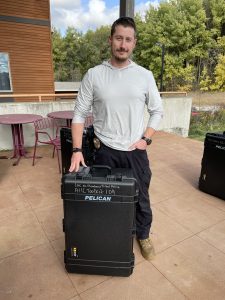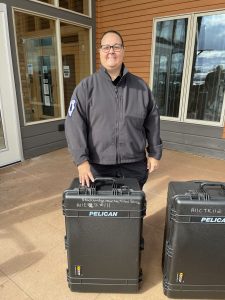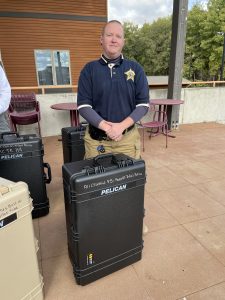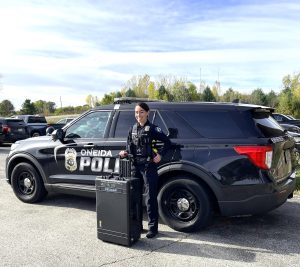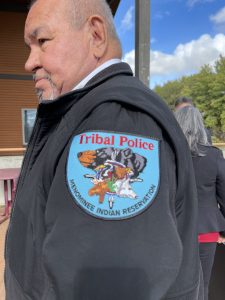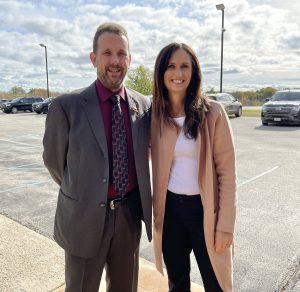
By Denise Gee Peacock
The AMBER Alert Training and Technical Assistance Program (AATTAP)/AMBER Alert in Indian Country (AIIC) Initiative recently presented Technology Toolkits to six Wisconsin Tribal Nations during a quarterly Native American Drug and Gang Initiative Task Force Advisory Board meeting at the Oneida Indian Nation Police Headquarters in Oneida.
Each durable, portable Technology Toolkit—containing a rugged laptop, webcam, digital camera, scanner, a hotspot device with six free months of WiFi (in partnership with the FirstNet Authority and AT&T)—is geared to help Tribes work more quickly and efficiently in the field during missing child investigations. Funding for the Toolkits, offered to any federally recognized Tribe, is provided by the U.S. Department of Justice and Ashlynne Mike AMBER Alert in Indian Country Act of 2018.
The Toolkit endeavor was devised during the pandemic, “when we saw a significant need for tools and resources in Indian Country that would allow law enforcement to work remotely,” said AATTAP Administrator Janell Rasmussen.
“Some Tribes didn’t have a webcam to participate in virtual meetings, or they had issues with broadband or Wi-Fi access, so we decided to put together a Toolkit that could help in any way possible when a child was missing in Indian Country.”
“Often when Tribal law enforcement go to a home to get a photo of a missing child, the picture they need may be the only one they have—and they don’t want to give it away because they might not get it back. The printer’s scanner feature helps to capture a digital image of the photo and allows the family to keep the photo.”
“And with the hotspot it provides, that photo can be immediately transmitted to whoever is creating the Alert to send out,” said AATTAP Program Manager Jenniffer Price-Lehmann, a Wisconsin native with decades of high-level law enforcement experience in the state. “That’s a major time saver, and we all know how critical time is when searching for a missing child.”
Rasmussen also highlighted the training provided by the AMBER Alert in Indian Country team led by AATTAP/AIIC Program Manager Tyesha Wood and AATTAP/AIIC Program Coordinator Valerie Bribiescas, who have so far provided more than 100 Toolkits to Tribal nations—and countless hours of training and assistance.
Wood told the group that “Indian Country training is completely customized to your needs, and all the trainings are free, whether they’re online or in person,” she said. “As for the in-person trainings, we also have travel scholarships available to help people attend any training session that would increase their agency’s response within their Tribal community.”
Rasmussen praised Wisconsin for its successful, proactive work to “build bridges of communication”—pointing out meeting attendee Melissa Marchant, the AMBER Alert Coordinator and Missing Persons Clearinghouse Manager for the Wisconsin Department of Justice (DOJ)/Division of Criminal Investigation (DCI). “Not every Tribe or state has such a dynamic system or team in place to work seamlessly during a missing child crisis. That’s why we’ve been working with Tribes across the nation to ensure that those without ready access to the equipment or contacts needed to issue an AMBER Alert can be prepared before an Alert is needed.”
“As of today, 1,146 kids are back at home safe because an AMBER Alert was issued, the public saw the Alert, and someone helped law enforcement get that that child back home. So this program works. And it works because of everything you do to make it work.”
– AATTAP Administrator Janell Rasmussen
Funding for the AATTAP’s AMBER Alert in Indian Country Technology Toolkit project is provided by the U.S. Department of Justice and Ashlynne Mike AMBER Alert in Indian Country Act of 2018—passed nearly two years after Ashlynne was kidnapped and killed May 2, 2016, near Shiprock, New Mexico, on the Navajo Nation Reservation.
At the time, Navajo Nation law enforcement officers did not have an AMBER Alert plan to notify the people living in the 27,000 square mile reservation that stretches from Arizona to Utah. As Ashlynne’s case progressed, it brought to light gaps in public safety preparedness and coordination to best respond to cases involving missing and abducted children.
Ashlynne’s mother, Pamela Foster, lobbied legislators such as the late Senator John McCain of Arizona to pass the law, which provides funding and training for increased law enforcement coordination, new and expanded resources, and renewed hope for protection of children living on Tribal lands across the U.S.
“The Navajo Nation has worked very hard to put together an incredible alert system in Ashlynn’s memory,” Rasmussen said. After eliminating jurisdictional confusion and hurdles, the Nation now issue their own Alerts. And they have resulted in the successful recoveries of Navajo children. So this initiative is definitely working.”
“Traditionally the cooperation between federal, state, local, and Tribal law enforcement is not good. So kudos to my predecessors, who were able to lay the foundation for the solid relationships with have in this state, one we continue to build on. We wouldn’t be able to function properly without that.”
— Oneida Nation Police Chief Eric Boulanger


